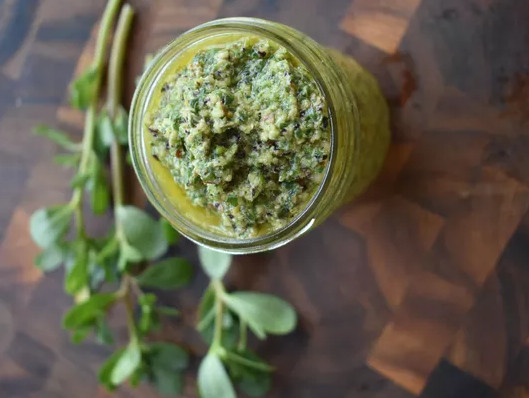Rather than cursing every weed that graces your garden this summer, consider the motto, “If you can’t beat them, eat them!”
Of all the edible leafy green invaders, purslane is one of the most palatable and nutritious.
You’ve almost certainly seen this succulent weed, which looks much like a mini version of a Jade houseplant, growing between the cracks of a sidewalk or stubbornly invading your raised bed garden, but have you ever considered consuming it?
Purslane, Portulaca oleracea, or “little hogweed,” is native to India and Persia, but has spread across the world thanks to its drought tolerance and ability to grow almost anywhere. Many food cultures, including those of Crete and Uzbekistan, embrace purslane as a nutritious staple.
Early Americans, including Martha Washington, enjoyed it both raw and pickled, but its use largely died out in the early 1900s.
Thankfully, farmers, foragers and forward-thinking chefs are beginning to rediscover this beneficial weed.
I first became aware of purslane in Michael Pollan’s book “The Omnivore’s Dilemma,” where he refers to it as one of the most nutritious plants in the world. I promptly forgot about it until years later, as my husband as I were working a shift pulling weeds at Wellspring Farm in exchange for our community share CSA box.
As we uprooted handfuls of purslane, one of the farmers educated us about its culinary and medicinal uses. Later that week, it showed up for sale at the market, and they let us take some home for free.
Since looking more deeply into the health benefits of purslane, I’ve only been more inspired to spread the word about its edibility. Dr. Artemis Simopoulos of the Center for Genetics, Nutrition and Health, referred to purslane as “a miracle plant,” after discovering it contained more omega-3 fatty acids than any other green plant. Research has credited these anti-inflammatory fats with improving joint pain, supporting brain health and improving sleep quality, to name just a few of their benefits.
Amazingly, purslane also boasts seven times more vitamin A than carrots and six times more vitamin E than spinach. There are plenty of resources instructing gardeners how to successfully rid their plots of purslane, but fewer on how to eat it.
Of course, when foraging purslane, pluck plants only from areas you know are free of pesticides or other contaminants. Farmers markets may also be a good source for finding toxin-free greens. Purslane leaves and stems are tastiest when small; aim to harvest before the plant’s yellow flowers appear and wash well before eating. Purslane’s herbaceous flavor is peppery, with notes of lemon and cucumber. To embrace its crisp texture, eat it raw: as a unique salad accompaniment, a replacement for lettuce or pickles on a sandwich, or to artfully top a bowl of soup. Purslane can also be sautéed gently along with kale and garlic or thrown into a hot pan of radishes, turnips and peas until just wilted and topped with lemon juice and olive oil.
Ashleigh Spitza is a registered dietitian and freelance writer in Wauwatosa who blogs at funkybeetsblog.com. Sources: University of Illinois Extension, Eat the Weeds (eattheweeds.com)
Looking to fool your friends? This recipe for purslane pesto is the perfect disguise to win over anyone wary of weed-eating.
Purslane and Basil Pesto
- Makes about 1 cup
- 2 cups young purslane leaves and stems, rinsed and roughly chopped
- ½ cup basil leaves, rinsed
- 1 clove garlic
- ½ cup toasted almonds
- Juice from half a lemon
- ½ cup olive oil
- Salt and pepper to taste
Add purslane, basil, garlic, almonds and lemon juice to the bowl of a food processor. Pulse until combined. With processor running, stream in olive oil until emulsified. Season with salt and pepper to taste. Enjoy on a toasted sandwich, over roasted vegetables or meat or tossed with pasta.
Credit: www.jsonline.com

